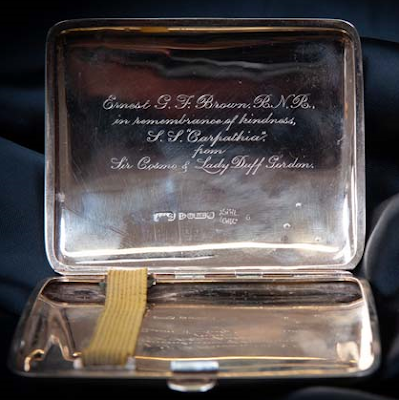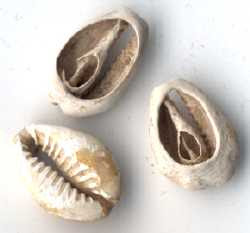 | Paleontologists announced the discovery of an "exceptionally well preserved" ancient creature near the eastern shore of Lake Simcoe in southern Ontario. It was found in a stone quarry that scientists have dubbed the "Paleo Pompeii." Named Tomlinsonus dimitrii, the specimen is part of an extinct group of arthropods known as marrellomorphs that lived approximately 450 mya, during the Ordovician period. Researchers discovered the bizarre arthropod last summer during a formal excavation of an active quarry. Similar to the Burgess Shale, the Lake Simcoe quarry was once submerged and part of a shallow ancient tropical marine sea. |
Tuesday, April 26, 2022
450 myo Tomlinsonus dimitrii
Monday, April 25, 2022
Ancient puppy in permafrost
 | This 18,000-year-old puppy, preserved in the Siberian permafrost, still has its whiskers. The puppy’s remains were identified by researchers at a site near Yakutsk in eastern Siberia in 2019. Researchers have determined that the animal is male, was 2 months old when he died and lived around 18,000 years ago. DNA testing could not determine if he was a dog or a wolf. Research suggests that dogs and wolves may have diverged from a common ancestor around 40,000 years ago, although some dog breeds may have bred with wolves after that point. |
Sunday, April 24, 2022
"Ides of March" Coins
 | Brutus issued a silver denarius celebrating the assassination of Caesar on the Ides of March (March 15). The denarius has a portrait of Brutus on the obverse, with on the reverse a liberty cap flanked by two daggers over the inscription EID(ibus) MAR(tiis). The liberty cap was the garment given to a manumitted slave to indicate his free status, so the reverse side symbolizes Brutus and Cassius liberating Rome with their daggers. There are about 60 known copies of the silver denarius. A superb example made $332k in a 2016 auction. Silver specimens in extremely fine condition have sold at auction for $120k. Low grade silver examples will make $50k. |
 | An ‘Ides of March’ aureus is one of three known examples. It was recently discovered hidden away in a private European collection. The coin is in mint condition and has been described as “the undisputed masterpiece of ancient coinage.” It made $3.5m. |  |
 | In October of 42 B.C., months after the coins were struck, Brutus and Cassius were routed by Marc Anthony and Octavian’s forces and died in the Battles of Philippi. Their coins were outlawed and very few survived. |
 | The famous 'Eid Mar' aureus on loan to the British Museum for the past decade has been offered for sale. It will be sold at auction on May 30 in Zurich and is expected to fetch more than £1.5 million (US$2m). The coin was minted by Marcus Junius Brutus to commemorate the assassination of Ceasar. The coin shows an inscription that reads “EID MAR” short for Eidibus Martiis, the Ides of March, along with two daggers and a liberty cap symbolizing freedom. The other side of the coin features a portrait of Brutus with the inscription “BRVT IMP” or Brutus, Imperator. |
Sweden’s Sandby borg yields gold
Saturday, April 23, 2022
Infamous Titanic gold cigarette case
 The cigarette case made $50k. | A gold cigarette case that once belonged to a controversial wealthy couple that survived the Titanic disaster was auctioned. The artifact belonged to Sir Cosmo and Lady Duff-Gordon. The couple were accused of bribing their way off the doomed liner. Sir Cosmo Duff-Gordon, his fashion designer wife, and her secretary, were among 12 who escaped the sinking ship on Titanic’s Lifeboat Number 1. The lifeboat, dubbed the 'millionaires’ boat,' had a capacity of 40. |   |
 | Sir Cosmo Duff-Gordon gave each of the 7 crewmembers who had shared his lifeboat £5. Occupants of Lifeboat 1. Middle Row: Hendrickson, Lady Duff Gordon, Francatelli, Sir Duff Gordon, Taylor. |  |
Thursday, April 21, 2022
Machu Picchu and the Golden Empires of Peru
| Over 3,000 years of Peruvian civilization is on display at the Cité de l’Architecture et du Patrimoine in Paris, France. The exhibition, which runs until Sept 4, combines virtual reality and hundreds of archaeological treasures from ancient Peru. Objects on display include ceramics, textiles, jewelry, headdresses, earrings, funerary masks, imperial dresses, silver crowns, and hundreds of gold pieces. After its stopover in Paris, the exhibition “Machu Picchu and the Golden Empires of Peru” will travel to other cities around the world. |
 |  |  |
Saturday, April 16, 2022
2000 yo granite sarcophagus in Alexandria
 | In 2018 archaeologists in Egypt opened a mysterious ancient black granite sarcophagus. The massive coffin was excavated in the city of Alexandria. |  Three skeletons and sewage water were found inside. |
 | A layer of mortar between the lid and the body of the sarcophagus indicated that it has not been opened since it was closed more than 2,000 years ago. The sarcophagus was found buried 16.4 feet below the surface. A carved alabaster head, which may depict one of the tomb’s occupants, was also discovered. The Ministry of Antiquities said one of the skeletons bore an arrow wound, evidence the men might have been soldiers. Measuring nine feet long, the black granite coffin is the largest ever to have been discovered in Alexandria. It was speculated that it might have contained the remains of Alexander the Great, who legend rumored is buried there. |  |
 | Three drawings, incised on three sheets of gold, have been discovered in a massive black granite sarcophagus in Alexandria. Researchers also learned more about the three skeletons. One came from a woman who was between 20 and 25 years old when she died, while the other two came from men who were in their 30s or 40s. |  |
 | The enigmatic drawings show what may be the seed pod of an opium poppy within a shrine. Opium was popular at the time. The skull of one of the men has a hole. He may have undergone "trepanation," a medical procedure often used in ancient times. |  |
Friday, April 15, 2022
‘Alien boy’ found in Crimean tomb was a trainee Sarmatian fighter
 |  |
Thursday, April 14, 2022
The Avar
 | The Avars, mysterious horse-riding warriors who helped hasten the end of the Roman Empire, dominated the plains between Vienna and Belgrade, Serbia, for more than 2 centuries. Then they vanished without a trace. The Avars left no written records. Grave goods and historical accounts of others suggest they dominated the plains of modern-day Hungary. Elites were buried in burial mounds, surrounded by weapons and finely decorated gold and silver vessels. They were often buried with horses. The earliest stirrups in Europe are from Avar graves. The first Avar burials were a near-identical match for an individual buried just a few decades earlier in eastern Mongolia. The first Avars in Europe probably made the journey of 7000 km themselves. After their arrival on the fringes of the Roman Empire, the Avars pushed into central Europe, along the Danube River between modern-day Vienna and Belgrade. They even lay siege to Constantinople, now Istanbul, in 623 C.E. They were defeated by Charlemagne. Their genetic signature soon dwindled to almost nothing in the regions they once ruled. The Avars faded into history and left only a mystery.  |
Tuesday, April 12, 2022
The rise of money
Humans have used currency as a means of exchange, a method of payment, a standard of value, a store of wealth and a unit of account for thousands of years.
Saturday, April 9, 2022
The Roman shoe hoard of Vindolanda
 | 1,800 years ago the Roman army built one of its smallest but most heavily defended forts at the site of Vindolanda. The small garrison of a few hundred soldiers and their families took shelter behind a series of large ditches and ramparts, while outside the walls a war was raging between the northern British Tribes and Roman forces. |  |
 With the debris were dog and cat skeletons, pottery, leather and 421 Roman shoes. | Once the war was over around 212 AD the troops and their dependents pulled out of the fort, and anything that they couldn't carry was tossed into the ditches. In 2016, archaeologists excavated the ditch and discovered an incredible time capsule of life. |  |
 | The shoe hoard gives an indication of the affluence of the occupants in AD 212 with stylish and well-made shoes, both adults and children’s. |
Thursday, April 7, 2022
Stone Age 'Lunch Box'
 | Glaciers and ice fields of the European Alps have lost half their volume to global warming, and their continued retreat is accelerating. By 2100 many scientists predict they will have all but disappeared. As glaciers recede, they are releasing human artifacts that they have absorbed through the ages, including humans themselves. Ötzi the iceman, the five thousand year-old mummified mountaineer discovered in 1991, is the most famous. |
Sunday, April 3, 2022
Hittite bracelet uncovered
| A man plowing his farm in Turkey’s central Çorum province discovered an extremely rare 3,300-year-old ancient bracelet from the Hittite era. The farmer, who lives in the Çitli village of Mecitözü district, found the bracelet and brought the ancient treasure to the Çorum Museum. The bracelet is made out of bronze, nickel, silver and gold and is adorned with depictions of Hittite symbols, including imagery of the Itar/Auka and his servants Ninatta and Kulitta. |
Subscribe to:
Comments (Atom)













